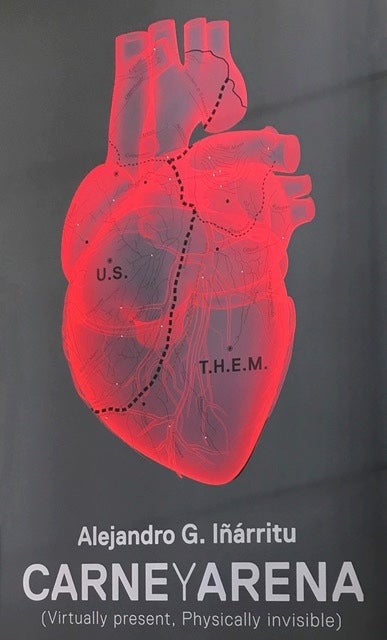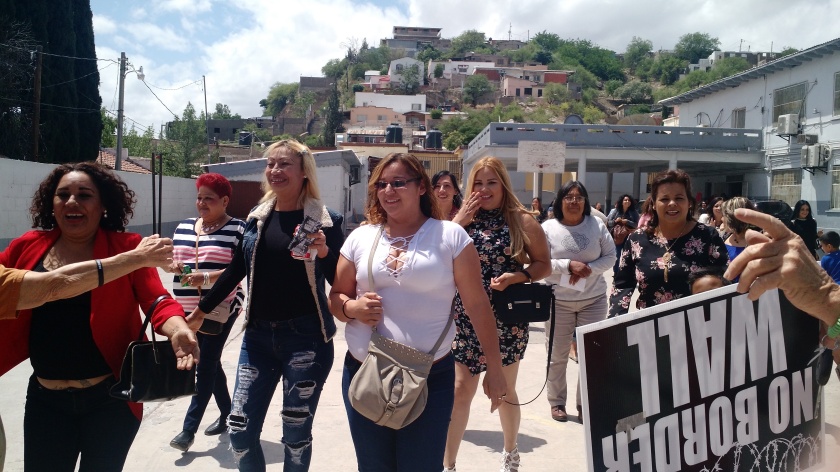As seen in the Huffington Post:
http://www.huffingtonpost.com/entry/597fd321e4b0d187a5968fcb
After all these years living near the Arizona-Mexico border, encountering the other lost and blistered, hobbling across our ranches… after countless heart-wrenching moments with men, women, and children whose bitter desert crossings would humble even the most conservative citizens, my colleague Antonia Gallegos and I emerged from DirectorAlejandro G. Iñárritu’s VR experience at the L.A. County Museum of Art, our faces wet with tears.
Iñárritu’s Carne y Arena: Flesh and Sand, a virtual reality tour de force, “drops a depth-charge into the souls of all who experience it,” writes Reverend Jim Burklo, Associate Dean of Religious Life at the University of Southern California, part of our visiting group who also left the exhibit in tears. Rev. Burklo wonders now how religious and other faith leaders can incorporate similar empathy-inducing technology. Iñárritu’s Virtual Reality experience brings you to your knees then leaves you wanting more. In the filmmaker artist’s hands, the migrant experience is no longer an abstraction. It now lives in the body, in your body.
As contributors of many of the Carne y Arena’s artifacts from the Arizona desert, we were invited to experience it for ourselves. Iñárritu’s VR experience, kept under wraps, is still largely a mystery, rare in this transparent age. The mystery was better understood after we realized, like eyewitnesses to an accident, each viewer-participant experiences a different Carne y Arena.
My own experience began as soon as I opened the door to an ice-cold waiting area outfitted with prison-issue steel benches bolted to the floor.
Once there, I do not sit down. The room is littered with a hazard of old shoes and bottles, tied together in clumps. Some of the gallon water bottles are covered with burlap, wrapped around the circumference. Denim pant sections or strips of cotton shirts cover others.
Random shoes are kicked askew, some singles, some in pairs, damaged and new. There are boots, running shoes, and sandals made from tire rubber. I recognize one shoe: a child’s sneaker, one of many I had found in the desert, this one molded into a crescent shape by the sun, dried out like vegetable skin, the rubber ossified.
Still standing, I bend down and reach under the bench to turn the shoe over. The dead can sometimes be identified by distinctive patterns on the sole. Suddenly, a voice from who knows where booms:
“D o n’ t t o u c h t h e s h o e s.”
I damn near jump out of my skin. O.K., I get it. I am not alone. I am being watched, every movement monitored. I shake my head, a reflex no doubt also recorded. I am already creeped out and the VR hasn’t even started yet. I pace the length of the room and pace some more.
I’ve been told to put my stuff in a locker. I see a sally port, a Detention Center special, in the wall at eye level. The silver-gray sally port looks like a refrigerated locker in the morgue. I place my shoes and hat inside.
A door alarm sounds and I step through it barefoot, gingerly, onto a field of sand. Immediately, my naked feet have posted to my brain: Alien. This place is alien and I am vulnerable.
I steal a quick breath and walk into a large space, lit only by hot red tubing demarcating the square shape of the room. I walk towards two shadowy figures in a far corner. They touch my shoulder to steady me, fit a pair of goggles over my glasses, then tighten straps over my head like deep-sea diving gear. They then slip a 7 – 8 lb. pack on my back. How children or elders carry such weight plus heavy gallons of water across a desert is beyond my comprehension.
The shadowy helpers demonstrate how they will signal me in case I find myself running into a wall or falling. Oh, I might fall or run into a wall? I am now officially destabilized. I tell myself It’s going to be O.K. I’ll make it through. This is virtual reality, right? It’s not real.
I see helicopters on the horizon, fump, fump, vibrating through my chest. At first, the helicopters sound far away and then near, too near. Beams of light cut through the night. Figures emerge: men, women, children, screaming and crying. Suddenly Border Patrol vehicles appear, trapping us in their high beams.
Faceless men in uniform jump from the vehicles with weapons drawn, and pin us to the ground like bugs. They are screaming a chaos of Spanglish, so loud I cannot understand what anyone is saying. One officer holds back a huge dog that won’t stop barking and I am choked with fear.
“Down, get down!” a male voice thunders in my ear.
We drop to our knees. I find myself praying, please don’t kill me, please don’t kill me. I start to cry even as the other part of my brain knows that this cannot be real.
I see one woman injured badly and another trying to help her up. A child nearby, maybe four years old, holds his hands up in the air and an officer, points a weapon in his face. Oh, God, please, please don’t let the gun go off, I plead silently. Two more officers yell at another man on his knees.
“Are you the smuggler? Are you? Are you the smuggler?”
Suddenly, in the middle of one nightmare, another emerges. A new tableau: figures around a table. The table starts to shape-change, and something moves there, twisting, writhing, and I struggle to understand what I am seeing but my attention is ripped away. The officers have just discovered other people hiding behind the cacti.
“Vamonos, Vamonos!
Behind me, the two women, one holding the other up, limp to the squad cars, stumbling and falling half-way. They manage to get to their feet, then pass right through me like ghosts. God. A long shiver creeps up my spine.
Suddenly the scene changes, night becomes day and I see articles of clothing snagged amongst the cacti, a forlorn aftermath of capture: The sky melts into morning orange. Across the clouds, a flock of birds flies in a silent elegant formation. I stand still, shocked by the beauty.
A tug on the back of my backpack and it’s over: I feel undone, like a book that has been slammed shut in the middle of the story. Helpers pull off my gear and point me to the way out.
Rattled, teeth to bone, I enter a long dark hallway. Tucked into individual niches in a black wall are Cinematographer Emmanuel Lubezki’s video portraits of the people whose experiences informed Carne y Arena. The viewer-participant has the choice to lean in, eye to eye, each face just inches away.
As you fall into each person’s skin, personal stories slowly unfold in chunks of text on the screen. Like the contemplative Christian practice of Lectio Divina, you read slowly. The word becomes flesh and you listen with the ear of your heart.
This contemplative part of the experience proves to be as compelling and intimate as the VR, and a necessary balance to its kinetic intensity. But even here, Iñárritu does not let the viewer entirely off the hook. Loud metallic groans blast periodically from the old rusted steel border wall behind us. Reality meets virtual reality.
The Arts have the power to guide us into a liminal state where boundaries – blessedly – dissolve and merge. The embodied imagination, the ‘sensorium’ within, lifts us into a mystical oneness. Drama, music, movement, the visual arts – all gifts of grace – are in accord with the divine.
According to Wikipedia, the root of the word Technology is techne, “art, skill, cunning of hand.” The technology of Art, in whatever form it takes, holds utility and applications limited only by our vision.
Political leanings aside, we can agree that the technology of Art, now more than ever, engages the imagination, fosters empathy, and restores well-being in our communities. And where there is shared vision, there is hope.
Places of worship can revitalize their congregations and champion genius art-making by simply opening their doors to artists. Contemplative space and support go a long way to encourage art and community, empathy and faith.
At day’s end, another member of our group emerges from the experience, eyes wide and shiny.
“I just wanted to help those women that were hurt and I couldn’t. I couldn’t help them,” she said.
I’d bet my easel and my paints, she is inspired now to find a way to help them.
































